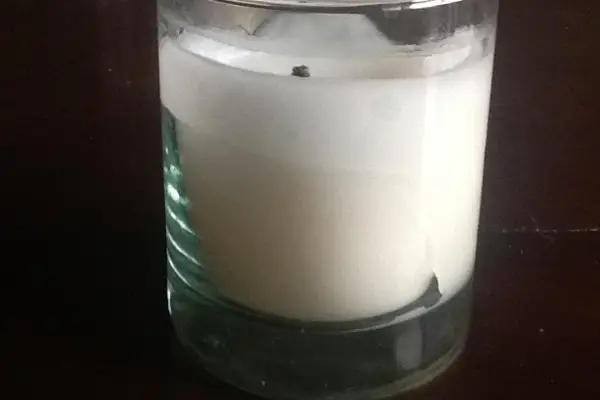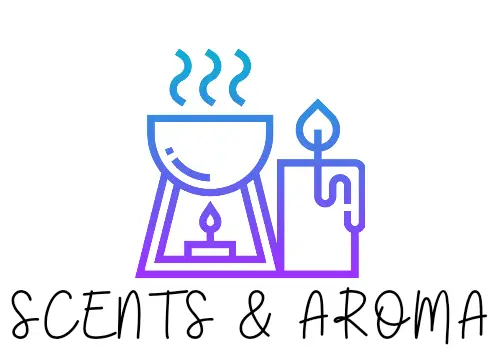Candle wet spots don’t affect a candle’s performance. However, as a matter of aesthetics, the imperfection after hard work, time, and money can be disheartening. If you are new to the candle world, wet spots are something you should try to avoid.

What are candle wet spots?
I want to start off with the basics just in case you stumbled upon here accidentally and had heard about candle wet spots.
So what are candle wet spots? We describe a candle wet spot as patches or spots in the candle jar that appear through the glass or a transparent container to look wet. They are caused by air bubbles and shrinkages that occur when the wax is cooling inside the jar if there is not the correct adhesion between the wax and the container.
What causes a wet spot on a candle?
So now we know what a candle wet spot is and what it looks like but we need to find out what causes it. Then we can move onto ways that we can reduce the chances of it happening.
So what causes a candle to get a wet spot?
Candle containers are usually made from cement, glass, ceramics, and aluminum. By design, candle makers need the wax to stick to the container surface with a process called adhesion. Adhesion is how well the wax holds onto the surface container.
Candle wet spots occur when the wax does not adhere to the glass.
How do wet spots occur? Candle wet spots occur when the wax does not stick to the container edge. Put differently, when wax pulls away from the container’s edge. When you heat the wax, it expands. However, when it cools, it contracts. During the expansion and contraction phase, the volume of the candle changes significantly. The candles also go through a micro-temperature change during this process. However, when the temperature changes, there is a risk that the candle will pull away from the jar side.
When the wax cools quickly and at different rates, it will pull away from the container edge. As a result, it creates air pockets and an uneven look on the container. Although your candle can appear perfect at first, when the temperature changes, wet spots will appear.
What causes candle wet spots?
Now that we know all about the reasons why a candle gets wet spots we can look at some of the ways that we can eliminate or at least reduce the chances.
Improper cooling and pouring
When your candle cools the wrong way, it will affect the heat distribution. Not only this, but it affects adhesion. Also, when you let your candle cure during temperature fluctuations, it can cause adhesion problems. Don’t cool your candles too fast or subject them to an environment with drafts or lower than 70-degrees.
Dirty containers
Don’t use dirty containers for your candle. Dirty jars or containers contribute to wet spots even if you get the temperatures right. For example, if the container sides have grime, dirt, or dust in it before you add your candle, it will create an adhesion problem later.
Poor pouring conditions
Poor pouring conditions will also create wet spots. As we said with improper pouring and cooling, pouring your candles at the wrong temperature or into a container that is too cold will affect the wax.
The wrong wax type
Candle waxes are not equal. As a result, using the wrong wax type can be why you see different wet spots. For example, using a votive or pillar wax for container candles. Instead of using any type of wax, use special wax blends made for container candles. This should improve the adhesion.
Check out this post that I wrote about the different types of candle wax and their benefits and negatives.
How to fix candle wet spots
You can fix candle wet spots by heating the area and its surrounding up to the surface with a heat gun. Heating the candle will displace wax and let them fill areas with poor adhesion. After filling the spots, heat the surface wax to smoothen the candle. Heat the area, and let your candle cool evenly.
Now, that is one way to fix wet spots. However, heating your candle can change the wax color and cause frosting. Since wet spots don’t necessarily affect how your candle burns, you can learn what caused it and avoid it entirely. In other words, avoiding wet spots is better than fixing them.
Another way to conceal a wet spot if it is not too severe is to strategically place a label over it.
How to avoid wet spots
Clean your containers
Don’t pour the wax into a container that has been sitting around for a while. You can prevent wet spots associated with dirty containers by thoroughly washing and drying your containers before use. This eliminates dirt, debris, and dust particles. Wash your container with soapy and mild water and dry it.
Preheat your containers
Another way to avoid wet spots is to preheat your containers. You can use a heat gun or leave them in the oven. Preheating your containers prevents the sides from heating first and ensures even cooling. Apart from preventing wet spots, candles that cool from the sides can sink in the middle – another problem you should avoid. Heating your container lets air bubbles escape to the surface and lets the wax cool more slowly.
Pour your wax at a low temperature
Close the temperature gap between the wax and the sides of the container by pouring the wax at lower temperatures. This action reduces the chances of separation when it is cooling.
Use a container wax or blend
Since using the wrong container can affect adhesion, ensure to use a container wax designed for container candles. You can also try different wax blends or wax that adheres well.
Tap on your containers after pouring
After pouring the wax, tap on the container sides to force bubbles trapped in the wax to the surface. This exercise also prevents tunneling and sinkholes.
Use appropriate curing and cooling techniques.
Container candle wax often takes weeks to cure. However, temperature fluctuations during these periods affect curing and cause adhesion problems. To avoid this, let your candle cure in a place with a steady temperature. Also, let your container cool without drawing heat from other containers. If you are working on more than one candle container, space them out on a cooling rack so that they don’t affect each other as they cool. Try to place them about 4-inches apart.
Too learn more about curing waxes have a read of this article I wrote.
Conclusion
Candle wet spots don’t alter how your candle burns. Although purely aesthetics, you can either accept when they happen or prevent them. The next time you see a wet spot on your candle, do not act shocked or surprised. You can either fix it, cover it, or avoid it next time.
- Can You Put Perfume In A Humidifier? (Read First) - September 17, 2022
- Can You Put Essential Oil In A Steam Mop? (Safety Advice) - September 17, 2022
- How To Make Lavender Oil At Home ( Candles And Diffusers) - September 9, 2022
